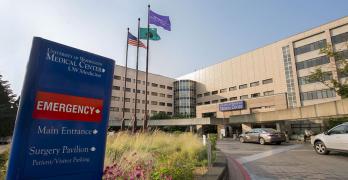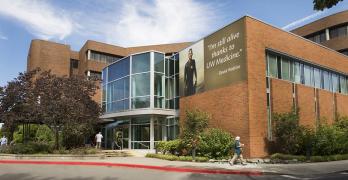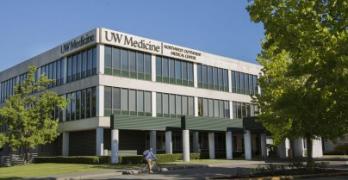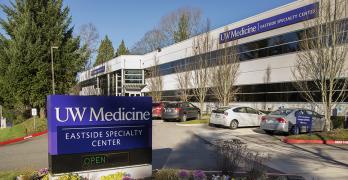Radiology
State-of-the-art imaging for fast, accurate results from head to littlest toe

Latest advances in diagnostic and interventional imaging.
Proven Expertise
Our accomplished technologists and expert radiologists are dedicated to delivering the highest level of care, and our patients give us a 98 percent satisfaction rate.
Focus on Safety
Our radiation equipment features new technology, like advanced dose-reduction, and our team of physicists provides 24/7 dose monitoring for every patient, across different types of scans.
Here for You
With convenient locations across the Puget Sound region, we offer same- and next-day exam availability with a quick turnaround time on results delivered to your inbox.
Below are links to a variety of imaging exams utilized by UW Medicine's Radiology Services. Each exam covers a range of procedures. Click on any of the following links to learn more about a given exam or procedure.
Bone densitometry is used to assess your bone health and fracture risk. This handout explains how the exam works, how to prepare for it, what to expect during the exam and how to get your results.
Interventional Radiology (IR) is one of the most exciting and advanced fields in medicine, but it is also one of the least well known. IR uses the latest in imaging technology to perform minimally invasive procedures throughout the body. Procedures that once required large incisions, general anesthesia, and days or weeks in the hospital can now be done on an outpatient basis with an incision so small that it does not require stitches.
Please select a procedure from the following list:
- After sclerotherapy sclerotherapy injections
- Anesthesia for your radiology exam or procedure
- Carotid angiogram
- Chemoembolization
- Chest port
- Inferior vena cava filter
- Percutaneous abdominal or pelvic drain
- Percutaneous dialysis fistula graft
- Percutaneous gastrostomy
- Percutaneous or transjugular liver biopsy
- Radiation effects during angiography
- Radiofrequency ablation
- Tunneled central venous catheter
- Transjugular intrahepatic portosystemic shunt procedure
- Transjugular liver biopsy
- Uterine fibroid embolization
- Vertebroplasty and kyphoplasty
- Yttrium-90 radiotherapy
CT imaging—sometimes called CAT scanning—is a noninvasive test that helps physicians diagnose and treat medical conditions. CT combines special X-ray equipment with sophisticated computers to produce multiple images or pictures of the inside of the body. These cross-sectional images of the area being studied can then be examined on a computer monitor or printed.
Please choose from the list below to learn more about your CT procedure:
- CT abdominal scan
- CT abdominal scan with Intravenous Pyelogram
- CT angiography
- CT contrast injections
- CT contrast reaction
- CT contrast reaction - If You Have Had Contrast Allergy
- CT calcium scoring
- CT chest scan
- CT coronary CTA scan
- CT guided nerve block
- CT guided biopsy of organs and lymph nodes
- CT guided lung biopsy
- CT head scan
- CT lung cancer screening
- CT musculoskeletal scan
- CT neck scan
- CT scan doses
- CT sinus screening
- CT spine scan
- CT virtual colonoscopy
- Anesthesia for your radiology exam or procedure
- Sedation for your radiology exam or procedure
- Delay Reaction to IV Contrast: Follow Up and Self Care
- Metformin and your scan: Important Instructions
A mammogram is an imaging test to find breast cancer. It uses X-ray to take images of the breasts. There are two types of mammograms: Screening mammograms are used to find breast cancer in women who do not have breast symptoms or complaints. Diagnostic mammograms are used to look for the cause of a symptom, such as a lump in the breast.
Fluoroscopy is an imaging technique that uses X-ray to obtain real-time moving images of the internal structures of a patient through the use of a fluoroscope. A video camera allows the images to be recorded and played on a monitor. Please choose from the list below to learn more about the various fluoroscopy procedures:
- Anesthesia for your radiology exam or procedure
- Cystogram
- Defecography
- Esophagram
- Fluoroscopy guided steroid injection
- Lower GI exam (barium enema)
- Lower GI exam: How to prepare for your exam
- Lumbar puncture
- Myelogram
- Pharyngogram
- Retrograde urethrogram
- Sedation for your radiology exam or procedure
- Small Bowel follow-through exam
- Sniff Test (chest fluoroscopy)
- Upper GI exam
An X-ray (radiology exam) is a medical test that produces images (pictures) of a part of a body. These images help doctors diagnose health conditions. Doctors use bone X-ray to view and assess broken bones, skull fractures and spine injuries. Bone X-ray may also be used to guide orthopedic surgery (surgeries that involve bones, joints, ligaments or muscles), treat sports-related injuries and diagnose advanced forms of bone cancer.
Magnetic resonance imaging (MRI) is a noninvasive medical test that helps physicians diagnose and treat medical conditions. MRI uses a powerful magnetic field, radio frequency pulses and a computer to produce detailed pictures of organs, soft tissues, bone and virtually all other internal body structures.
To learn more, please select from the following list of MRI procedures:
- MRI abdominal
- MRI angiography
- MRI arthrogram
- MRI brain scan
- MRI contrast injections
- MRI contrast reaction
- MRI contrast injection - If You Have Had Contrast Allergy
- MRI defecography
- MRI enterography scan
- MRI fetal
- MRI functional brain scan
- MRI gadolinium contrast
- MRI heart scan
- MRI lymphangiogram of arms and legs
- MRI magnetic resonance imaging
- MRI musculoskeletal
- MRI neck scan
- MRI neurogram
- MRI pelvic scan with prep
- MRI pelvic scan without prep
- MRI prostate
- MRI rectal
- MRI spectroscopy
- MRI spine
- Anesthesia for your radiology exam or procedure
- Sedation for your radiology exam or procedure
Nuclear Medicine uses small amounts of radioactive material to diagnose or treat a variety of diseases, including many types of cancers, heart disease and certain other abnormalities within the body.
To learn more, please select from the following list of Nuclear Medicine procedures:
- Anesthesia for your radiology exam or procedure
- Bone scan
- Brain DaTscan
- Brain perfusion scan
- Cardiac scan
- Cardiac PYP scan
- CSF leak scan
- DTPA GFR study
- Gastric emptying scan
- Gastric intestinal bleeding scan
- Hemangioma scan
- Hepatobiliary scan (HIDA scan)
- I123 MIBG scan
- I123 MIBG cardiac scan
- I131 radioactive iodine to treat thyroid cancer
- Renogram scan
- Liver/spleen nuclear medicine scan
- Lung V/Q scan
- Lymphangiogram of the extremities
- Lymphoscintigraphy for breast cancer
- Lymphoscintigraphy for skin cancers
- Multi-gated acquisition (MUGA)
- Octreotide study
- Parathyroid scan
- Sedation for your radiology exam or procedure
- Thyroid cancer dosimetry using l131
- Thyroid cancer survey using I123
- Thyroid uptake and scan
- Treating hyperthyroidism with radioactive iodine
- Xofigo therapy
Positron emission tomography (PET) and computerized tomography (CT) are both standard imaging tools that allow physicians to pinpoint the location of cancer within the body before making treatment recommendations. The highly-sensitive PET scan detects the metabolic signal of actively growing cancer cells in the body and the CT scan provides a detailed picture of the internal anatomy that reveals the location, size and shape of abnormal cancerous growths.
To learn more, please select from the following list of PET-CT procedures:
- Anesthesia for your radiology exam or procedure
- PET/CT cardiac inflammation scan
- PET/CT Cardiac Rest/Stress Perfusion Scan
- PET/CT Cardiac Viability
- PET/CT Cu-64 Dotatate Scan
- PET/CT F18 Fluoride Scan
- PET/CT FDG body scan
- PET/CT FDG brain scan
- PET/CT FDG scan for patients with diabetes
- PET/CT Ga-68 Dotatate Mid-body Study
- PET/CT Prostate Axumin Scan
- PET/CT Pylarify PSMA Scan
- Sedation for your radiology exam or procedure
Ultrasound examination, also called sonography or diagnostic medical sonography, is an imaging method that uses high-frequency sound waves to produce precise images of structures within the body. The images produced through ultrasound examination often provide information that's valuable in diagnosing and treating a variety of diseases and conditions.
To learn more, please select from the following list of ultrasound procedures:
- Anesthesia for your radiology exam or procedure
- Ultrasound: Abdomen
- Ultrasound: Guided aspiration of fluid collection
- Ultrasound: Guided biopsy
- Ultrasound: Guided fine needle aspiration
- Ultrasound: Guided lavage
- Ultrasound: Kidney exam
- Ultrasound: Kidney transplant
- Ultrasound: Liver transplant
- Ultrasound: Obstetrical exam
- Ultrasound: Pelvic exam
- Ultrasound: Prostate exam
- Ultrasound: Renal exam
- Ultrasound: Scrotal exam
- Ultrasound: Fine needle aspiration (discharge instructions)
- Ultrasound: Guided core biopsy (discharge instructions)
- Ultrasound: Guided paracentesis (discharge instructions)
- Ultrasound: Guided thorencentesis (discharge instructions)
- Sedation for your radiology exam or procedure
For radiology orders, please call 206.598.5800.
X-ray exams are walk-in only at all locations. No appointment is necessary for X-ray.
Providers: Please include chart notes and prior authorization with order to expedite scheduling.
UW Medical Center – Montlake, UW Medical Center – Northwest, Roosevelt Clinic and Eastside Specialty Center and NW Outpatient Medical Center Radiology Scheduling:
Phone: 206.598.7200 Fax: 206.597.4004
Call 8:00 a.m. - 6:00 p.m. for radiology appointments*, and please have your referral form or imaging order faxed prior to calling.
INTERVENTIONAL RADIOLOGY REFERRAL FORM
Harborview Medical Center Radiology Scheduling:
Phone: 206.744.3105 Fax: 206.744.8206
Call 6:00 a.m. – 6:00 p.m. for radiology appointments*, and please have your referral form or imaging order faxed prior to calling.
Breast Imaging Scheduling:
Phone: 206.668.1749 Fax: 206.668.1790 for Roosevelt Clinic, Eastside Specialty Clinic and Breast Imaging Clinic at UWMC Northwest.
Please call 206.606.7800 to schedule a mammogram at Fred Hutchinson Cancer Center.
Radiologist Consult Line (Medical Providers Only) for questions on ordering advice: 206.598.0101
To request radiology records: Visit Records & Images for information.
Complete and sign a patient authorization to disclose, release and/or obtain protected health information. When requesting images on behalf of a patient, please include a copy of your power of attorney. Please mail, fax or email your authorization form and images request to one of the locations below.
Please include the following patient information with your request:
- Last name, first name
- Date of birth
- Provider’s name
- Address where copy is to be mailed to
- Dates of service you are requesting
- When you need the images
UW Medical Center Radiology
1959 NE Pacific Street, BB312
Box 375115
Seattle, WA 98195
Phone: 206.598.6206
Fax: 206.598.7690
email: radrecs@uw.edu
Harborview Medical Center
Mailbox: 359738
325 Ninth Avenue
Seattle, WA 98104
Phone: 206.744.6730
Fax: 206.744.6374
UW Medical Center - Northwest
Health Information Management Department
1550 N 115th St., MS D129
Seattle, WA 98133
Phone: 206.668.1748 (NWH) / 206.668.1749 (SBC)
Fax: 206.668.1398 (NWH) / 206.668.1790 (SBC)
UW Medicine MyChart allows you to access test and imaging results and other health information online any time you need it. If you're signed up for MyChart, you can sign in to view your results at your convenience.
Inform yourself to make the best choices for your health and care with UW Medicine patient education resources.
- Outpatient MRI screening | Arabic | Chinese | Japanese | Korean | Russian | Spanish | Vietnamese
- CT Screening Form | Arabic | Chinese | Japanese | Korean | Russian | Spanish | Vietnamese
- Bone Density Screening Form | Arabic | Chinese | Japanese | Korean| Russian | Spanish | Vietnamese
- Mammography Screening Form | Chinese | Japanese | Korean | Russian
- Cardiac perfusion scan questionnaire
Emotional support is an important part of your treatment. Support groups and community resources can help you and your loved ones through treatment and recovery.
Most of our imaging procedures have a low risk of side effects from radiation exposure. But we continually work to reduce the radiation dosage of imaging tests while maximizing the benefits of these powerful disease-fighting tools. And each of our patients is closely monitored by a team of on-site physicists.
Vascular and interventional radiology (VIR) specialists deliver minimally invasive image-guided treatments for numerous conditions occurring throughout the body.
VIR specialists utilizes many non-surgical, minimally invasive treatments as alternatives to open surgical procedures. VIR radiology procedures are generally easier for the patient because they involve small incisions, minimal pain and shorter recovery times.
VIR radiologists use their expertise in X-rays, computed tomography (CT) scans, ultrasound, and other medical imaging technology to guide small instruments, such as catheter tubes, through the blood vessels or other pathways to treat medical conditions, rather than open surgery.
Examples of vascular and interventional radiology procedures include vertebroblasty, kyphoplasty, radio frequency ablation of tumors, angiography, balloon angioplasty and stenting to open clogged blood vessels, uterine fibroid embolization, spinal pain injections, and needle biopsy, among others.






